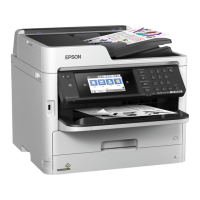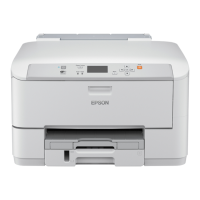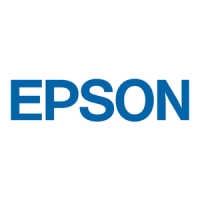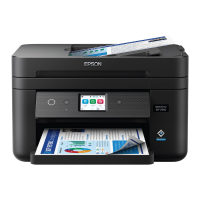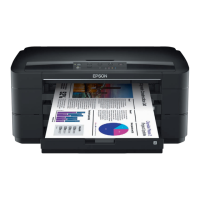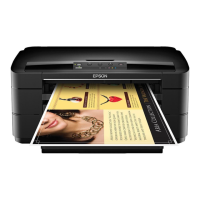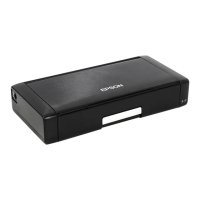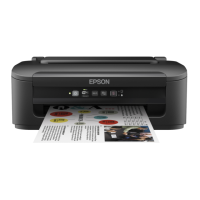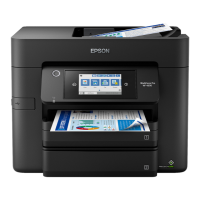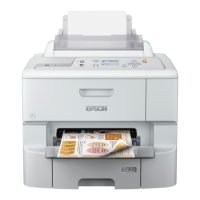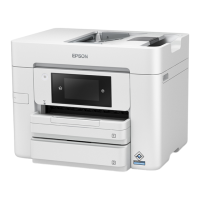Do you have a question about the Epson WorkForce Pro WF-M5399 and is the answer not in the manual?
Instructions for installing and using optional printer accessories like paper cassette units.
Identifies the printer's front components, including the control panel and paper cassettes.
Details the internal components of the printer, such as the printer cover, print head, and ink tray.
Identifies the printer's rear components, including ports like LAN and USB, and covers.
Details the function of each button and light on the printer's control panel for user interaction.
Explains the LCD screen layout, icons, and navigation principles for operating the printer.
Details how to adjust the time period before the product enters sleep mode and turns off the LCD screen.
Provides steps to activate the product's email address for Epson Connect services via the control panel.
Explains how to print documents by attaching them to emails sent to the product's unique email address.
Details how to print from a laptop or desktop computer to an Epson email-enabled product anywhere globally.
Describes using the free Apple and Android app to set up, control, and check the status of your Epson product.
Offers essential measures to protect the network environment and deter unauthorized access to the product.
Details how to set up the product to communicate with computers using a wireless router or access point.
Describes setting up direct communication between the product and devices without a router, acting as a network access point.
Explains how to quickly connect the product to a WPS-enabled wireless router or access point.
Guides on printing a status sheet to help diagnose network-related problems with the product.
Describes how to print a report to view solutions for network connection problems encountered with the product.
Details the process of changing the product's connection from USB to Wi-Fi, including software reinstallation.
Provides instructions for updating the product's Wi-Fi connection when the wireless router is changed.
Explains how to disable the product's Wi-Fi features, useful for changing network types or troubleshooting.
Covers the installation of the PCL driver on a Windows computer for PCL printing capabilities.
Details the installation of PostScript (PS3) printer software on Windows for advanced print settings.
Explains how to select PCL and PostScript printing settings using the product's control panel for customized output.
Offers detailed steps and guidelines for loading various paper types into the printer's paper cassettes and rear tray.
Lists the sheet capacity for different paper types across various paper cassettes and trays of the printer.
Details the number of sheets that can be used for auto duplex printing in paper cassettes for different paper types.
Provides information on purchasing genuine Epson ink, maintenance boxes, and paper, including contact details.
Maps specific paper types to their corresponding settings within the printing software for accurate media handling.
Guides users on changing default paper size and type for each source via the product's control panel.
Allows administrators to adjust default paper settings that apply to all print jobs sent to the product.
Explains how to change default printer settings using the control panel, including auto error solver options.
Details how to configure universal print settings via the control panel for consistent print job handling.
Explains how to print using the standard Epson printer software on Windows, detailing various print settings.
Guides on selecting fundamental print settings for documents or photos when printing from Windows.
Describes how to configure double-sided printing options directly from the main tab of the printer settings.
Details how to select various additional layout and printing options via the "More Options" tab in printer preferences.
Explains how to select pre-defined print settings (presets) for quick access to common configurations.
Covers selecting additional settings that apply to all print jobs, accessed through the printer's maintenance tab.
Guides users through saving print settings and initiating the printing process from their application.
Explains how Windows administrators can restrict access to certain printer settings to prevent unauthorized changes.
Details the requirement to enter a user ID and password when Access Control is enabled on the product.
Explains how to configure or disable automatic software update checks for the printer software.
Covers printing using the built-in driver on Windows 10 S, noting limitations on available settings.
Explains how to print using Epson's standard printer software on Mac, including checking for updates.
Details how to select fundamental print settings for documents or photos when printing from a Mac.
Guides on selecting paper size and orientation settings from the print window or page setup on Mac.
Covers selecting various layout options like pages per sheet and borders from the print window pop-up menu on Mac.
Explains how to select two-sided printing settings from the print window pop-up menu on Mac.
Guides on selecting general printing preferences for all print jobs sent to the product from a Mac.
Covers the final steps to print a document after selecting all print settings on a Mac.
Explains how to view print job progress, control printing, and check ink status using the printer icon in the Dock on Mac.
Explains how to print using PCL printer software on Windows, covering various driver settings.
Describes how to synchronize the printer driver with the product if it fails to detect correct information or settings.
Guides on selecting basic print settings for documents or photos using the PCL driver on Windows.
Explains how to set default print settings for all Windows programs when using the PCL driver.
Details how administrators can lock printer settings to prevent unauthorized changes for the PCL driver.
Covers printing using PostScript (PS3) software on Windows, including basic print settings and paper support.
Guides on setting default print preferences for all Windows programs when using the PostScript (PS3) driver.
Explains how to select basic print settings for documents or photos using the PostScript (PS3) driver on Mac.
Provides crucial safety precautions and handling guidelines for using and replacing ink packs to ensure safe operation.
Explains how to view ink and maintenance box levels directly on the product's LCD screen.
Guides on checking ink and maintenance box status using the Epson Status Monitor utility on a Windows computer.
Guides on checking ink and maintenance box status using the EPSON Status Monitor utility on a Mac.
Explains the importance of print head maintenance for quality and guides on performing nozzle checks and cleaning.
Describes how to print a nozzle check pattern using the control panel to identify clogged print head nozzles.
Details the procedure for cleaning the print head using the product control panel or a computer utility to resolve print quality issues.
Explains how to align the print head to correct issues like grainy printouts, vertical line misalignment, or banding.
Provides steps for aligning the print head using the printer's control panel, including options for ruled line and horizontal alignment.
Guides on adjusting print quality directly from the printer's control panel by printing a nozzle check pattern.
Instructs on cleaning the paper guide rollers to remove excess ink that may appear on printouts.
Details how to clean the translucent film inside the printer to resolve print quality issues potentially caused by ink smears.
Explains how to view the total number of pages that have passed through the printer using the LCD screen.
Explains how to access the printer's built-in Web Config utility via a web browser to manage network settings and status.
Details how to set or change the administrator password for accessing the Web Config utility and product features.
Describes how to check various status details of the printer, such as product, network, usage, and hardware status, via Web Config.
Guides on checking and updating the product's network information and settings using the Web Config interface.
Lists and describes the available network configuration settings within the Web Config interface, including IP addressing and DNS.
Explains how to configure the behavior of the product's control panel, including display language and panel lock settings.
Details the steps for configuring email server settings using Web Config to enable email notifications from the product.
Guides on setting up email notifications for product events, allowing registration of up to five destinations.
Explains how to configure the product's automatic sleep mode and power-off timers to conserve energy.
Covers exporting and importing product settings using Web Config, with options for encryption and password protection.
Details how to update the product's firmware using the Web Config interface, ensuring the latest software is installed.
Guides on synchronizing the product's date and time with an NTP time server for accurate timekeeping.
Explains how to delete internal memory contents, such as password-protected jobs and downloaded fonts, using Web Config.
Describes how to schedule print head cleaning cycles using the Web Config interface for regular maintenance.
Details how to connect an authentication device, like an IC card reader, via USB and check its functionality using Web Config.
Explains how to restrict product features for individual users by setting up user accounts and passwords via Web Config.
Covers restricting access via USB connection or connected USB devices/memory cards through Web Config.
Explains how to enable password encryption to protect confidential information stored within the product.
Details how to enable the Audit Log feature or export audit log data for tracking security issues or usage.
Explains how to protect files from unauthorized PDL operations using Web Config.
Describes how to check for tampering with product programs at startup using Web Config.
Explains how to enable or disable various network protocols and services using Web Config for secure and efficient operation.
Details how to configure SSL/TLS settings via Web Config to encrypt communications with the product using HTTPS.
Guides on configuring a server certificate for the product, including importing CA-signed or generating self-signed certificates.
Explains how to configure IPsec/IP traffic filtering using Web Config to control network access based on IP addresses, services, and ports.
Guides on configuring the default policy for IPsec/IP traffic filtering using Web Config.
Describes how to configure group policies for IPsec/IP traffic filtering to manage access for specific user or group connections.
Details how to configure a certificate for IPsec/IP traffic filtering using Web Config.
Provides instructions on connecting the product to an IEEE 802.1X network using Web Config for authenticated network access.
Covers the configuration of IEEE 802.1X network settings, including EAP type, User ID, and Password, in Web Config.
Explains how to check the status of IEEE 802.1X network settings by printing a status sheet.
Guides on configuring and using digital certificates for network security, including obtaining and importing certificates.
Explains the types of digital certificates (CA-signed, Self-signed) and their purpose in network security.
Details the process of obtaining a CA-signed certificate by creating a CSR and importing it into the product.
Lists the settings required for setting up a Certificate Signing Request (CSR) in Web Config.
Provides information on configuring settings when importing a CSR, varying by certificate format and source.
Explains how to delete an imported CA-signed certificate from Web Config when it expires or is no longer needed.
Guides on updating a self-signed certificate for HTTPS server features using Web Config.
Details how to import a CA certificate using Web Config, which is necessary for certain security features.
Explains how to access troubleshooting and how-to topics on the printer's LCD screen.
Advises users to periodically check Epson's support website for free updates to product software and firmware.
Guides on diagnosing problems by checking messages and status icons displayed on the printer's LCD screen.
Describes how to run a product check to determine if the printer is operating properly, including print head nozzle checks.
Explains how to reset product control panel settings to their factory defaults to resolve issues with configurations.
Provides troubleshooting steps for issues encountered during the product setup process.
Offers solutions for problems related to powering the product on or off, including checking power connections.
Provides troubleshooting steps for issues encountered during the installation of product software.
Offers solutions for common problems encountered when setting up or using the product on a network.
Provides troubleshooting steps when EpsonNet Setup cannot locate the product on the network.
Offers solutions if the printer does not appear in the Mac printer window, including restarting the product.
Provides troubleshooting steps for issues preventing printing over a network connection.
Addresses problems related to using the product's network security features, such as IPP printing and digital certificates.
Offers troubleshooting steps if a digital certificate cannot be imported, including checking file information and passwords.
Provides solutions if a CA-signed certificate was accidentally deleted, suggesting re-importing from a backup.
Lists common digital certificate warning messages and their corresponding solutions for resolving issues.
Covers troubleshooting steps for issues related to using paper with the product, including feeding and jamming problems.
Provides solutions for issues where paper does not feed correctly into the printer, including loading and settings checks.
Offers guidance on locating and removing jammed paper, including precautions to avoid product damage.
Provides solutions for issues related to paper not ejecting fully or being wrinkled upon ejection.
Offers solutions for various problems encountered while printing from a computer, including issues with nothing printing or slow printing.
Provides troubleshooting steps when no print jobs are produced, checking product status, connections, and software.
Offers solutions if the product icon is missing from the Windows taskbar, involving restarting the computer and checking settings.
Provides troubleshooting steps to address slow printing performance, considering system requirements, network factors, and software settings.
Addresses issues related to the layout and content of printed pages, such as inverted images or incorrect margins.
Offers solutions if the printed image appears inverted unexpectedly, suggesting checks for mirror or inversion settings.
Provides solutions for incorrect margins on printouts, focusing on paper size, margin, and positioning settings.
Offers troubleshooting steps if incorrect characters appear in prints, relating to cable connections and software.
Guides on correcting issues with printed image size or position, checking paper and layout settings.
Provides solutions if printouts appear slanted, involving paper loading, alignment, and print quality settings.
Offers solutions for print quality issues where the image appears fine on the computer screen but not in print.
Addresses issues with white or dark lines in prints (banding), suggesting nozzle checks, head alignment, and paper type verification.
Provides solutions for blurry or smeared printouts, including paper condition, loading, and cleaning the paper path.
Offers solutions for faint printouts or those with gaps, suggesting nozzle checks, ink replacement, and density adjustments.
Provides solutions for grainy printouts, focusing on print quality settings and nozzle checks.
Guides on uninstalling and reinstalling product software to resolve system issues or problems.
Details the steps for uninstalling printer software on Windows to resolve problems or prepare for reinstallation.
Explains how to uninstall product software on a Mac using the Uninstaller utility, usually for reinstallation.
Specifies the compatible Microsoft operating systems required to use the product and its software.
Lists the compatible macOS operating systems required to use the product and its software.
Provides details on paper types and specifications, noting that quality may vary by manufacturer.
Details the minimum printable area margins and reduced print quality areas for single sheets and envelopes.
Provides specifications for ink packs, including life, temperature storage, and color information, emphasizing genuine Epson products.
Lists the product's dimensions in stored and printing states, with and without optional paper cassettes.
Details the power supply rating, frequency range, rated current, and power consumption of the product.
Provides operating and storage temperature and humidity specifications for the product.
Lists the interface types supported by the product, including Hi-Speed USB, and notes limitations on USB 3.0 cables.
Details the Wi-Fi standards, security protocols, frequency bands, and connection modes supported by the product.
Lists safety and EMC compliance information for the United States and Canada, along with FCC/IC radiation exposure guidelines.
Offers crucial safety instructions for using the Epson product, covering power, handling, and environmental considerations.
Provides fundamental safety guidelines for operating the printer, including power source, cord usage, and placement.
Offers safety advice regarding radio waves from the product affecting medical or automatic devices and network connection practices.
Provides safety guidelines for cleaning and handling the printer's LCD screen to prevent damage or injury.
Details the FCC and IC compliance statements for the device, including operating conditions and warnings about modifications.
Outlines the terms of binding arbitration, waiver of class actions, and dispute resolution procedures between users and Epson.
Lists registered trademarks and product names associated with Epson and other companies mentioned in the manual.
States the copyright information, including reproduction restrictions and liability limitations for the publication's content.
Provides copyright and permission notices for the libTIFF software used within the product.
Encourages users to be responsible and respectful of copyright laws when using Epson products.
Explains that the product enters sleep mode after nonuse to meet Energy Star standards for energy efficiency.
Displays copyright information for Epson America, Inc., including version and publication date.
Instructions for installing and using optional printer accessories like paper cassette units.
Identifies the printer's front components, including the control panel and paper cassettes.
Details the internal components of the printer, such as the printer cover, print head, and ink tray.
Identifies the printer's rear components, including ports like LAN and USB, and covers.
Details the function of each button and light on the printer's control panel for user interaction.
Explains the LCD screen layout, icons, and navigation principles for operating the printer.
Details how to adjust the time period before the product enters sleep mode and turns off the LCD screen.
Provides steps to activate the product's email address for Epson Connect services via the control panel.
Explains how to print documents by attaching them to emails sent to the product's unique email address.
Details how to print from a laptop or desktop computer to an Epson email-enabled product anywhere globally.
Describes using the free Apple and Android app to set up, control, and check the status of your Epson product.
Offers essential measures to protect the network environment and deter unauthorized access to the product.
Details how to set up the product to communicate with computers using a wireless router or access point.
Describes setting up direct communication between the product and devices without a router, acting as a network access point.
Explains how to quickly connect the product to a WPS-enabled wireless router or access point.
Guides on printing a status sheet to help diagnose network-related problems with the product.
Describes how to print a report to view solutions for network connection problems encountered with the product.
Details the process of changing the product's connection from USB to Wi-Fi, including software reinstallation.
Provides instructions for updating the product's Wi-Fi connection when the wireless router is changed.
Explains how to disable the product's Wi-Fi features, useful for changing network types or troubleshooting.
Covers the installation of the PCL driver on a Windows computer for PCL printing capabilities.
Details the installation of PostScript (PS3) printer software on Windows for advanced print settings.
Explains how to select PCL and PostScript printing settings using the product's control panel for customized output.
Offers detailed steps and guidelines for loading various paper types into the printer's paper cassettes and rear tray.
Lists the sheet capacity for different paper types across various paper cassettes and trays of the printer.
Details the number of sheets that can be used for auto duplex printing in paper cassettes for different paper types.
Provides information on purchasing genuine Epson ink, maintenance boxes, and paper, including contact details.
Maps specific paper types to their corresponding settings within the printing software for accurate media handling.
Guides users on changing default paper size and type for each source via the product's control panel.
Allows administrators to adjust default paper settings that apply to all print jobs sent to the product.
Explains how to change default printer settings using the control panel, including auto error solver options.
Details how to configure universal print settings via the control panel for consistent print job handling.
Explains how to print using the standard Epson printer software on Windows, detailing various print settings.
Guides on selecting fundamental print settings for documents or photos when printing from Windows.
Describes how to configure double-sided printing options directly from the main tab of the printer settings.
Details how to select various additional layout and printing options via the "More Options" tab in printer preferences.
Explains how to select pre-defined print settings (presets) for quick access to common configurations.
Covers selecting additional settings that apply to all print jobs, accessed through the printer's maintenance tab.
Guides users through saving print settings and initiating the printing process from their application.
Explains how Windows administrators can restrict access to certain printer settings to prevent unauthorized changes.
Details the requirement to enter a user ID and password when Access Control is enabled on the product.
Explains how to configure or disable automatic software update checks for the printer software.
Covers printing using the built-in driver on Windows 10 S, noting limitations on available settings.
Explains how to print using Epson's standard printer software on Mac, including checking for updates.
Details how to select fundamental print settings for documents or photos when printing from a Mac.
Guides on selecting paper size and orientation settings from the print window or page setup on Mac.
Covers selecting various layout options like pages per sheet and borders from the print window pop-up menu on Mac.
Explains how to select two-sided printing settings from the print window pop-up menu on Mac.
Guides on selecting general printing preferences for all print jobs sent to the product from a Mac.
Covers the final steps to print a document after selecting all print settings on a Mac.
Explains how to view print job progress, control printing, and check ink status using the printer icon in the Dock on Mac.
Explains how to print using PCL printer software on Windows, covering various driver settings.
Describes how to synchronize the printer driver with the product if it fails to detect correct information or settings.
Guides on selecting basic print settings for documents or photos using the PCL driver on Windows.
Explains how to set default print settings for all Windows programs when using the PCL driver.
Details how administrators can lock printer settings to prevent unauthorized changes for the PCL driver.
Covers printing using PostScript (PS3) software on Windows, including basic print settings and paper support.
Guides on setting default print preferences for all Windows programs when using the PostScript (PS3) driver.
Explains how to select basic print settings for documents or photos using the PostScript (PS3) driver on Mac.
Provides crucial safety precautions and handling guidelines for using and replacing ink packs to ensure safe operation.
Explains how to view ink and maintenance box levels directly on the product's LCD screen.
Guides on checking ink and maintenance box status using the Epson Status Monitor utility on a Windows computer.
Guides on checking ink and maintenance box status using the EPSON Status Monitor utility on a Mac.
Explains the importance of print head maintenance for quality and guides on performing nozzle checks and cleaning.
Describes how to print a nozzle check pattern using the control panel to identify clogged print head nozzles.
Details the procedure for cleaning the print head using the product control panel or a computer utility to resolve print quality issues.
Explains how to align the print head to correct issues like grainy printouts, vertical line misalignment, or banding.
Provides steps for aligning the print head using the printer's control panel, including options for ruled line and horizontal alignment.
Guides on adjusting print quality directly from the printer's control panel by printing a nozzle check pattern.
Instructs on cleaning the paper guide rollers to remove excess ink that may appear on printouts.
Details how to clean the translucent film inside the printer to resolve print quality issues potentially caused by ink smears.
Explains how to view the total number of pages that have passed through the printer using the LCD screen.
Explains how to access the printer's built-in Web Config utility via a web browser to manage network settings and status.
Details how to set or change the administrator password for accessing the Web Config utility and product features.
Describes how to check various status details of the printer, such as product, network, usage, and hardware status, via Web Config.
Guides on checking and updating the product's network information and settings using the Web Config interface.
Lists and describes the available network configuration settings within the Web Config interface, including IP addressing and DNS.
Explains how to configure the behavior of the product's control panel, including display language and panel lock settings.
Details the steps for configuring email server settings using Web Config to enable email notifications from the product.
Guides on setting up email notifications for product events, allowing registration of up to five destinations.
Explains how to configure the product's automatic sleep mode and power-off timers to conserve energy.
Covers exporting and importing product settings using Web Config, with options for encryption and password protection.
Details how to update the product's firmware using the Web Config interface, ensuring the latest software is installed.
Guides on synchronizing the product's date and time with an NTP time server for accurate timekeeping.
Explains how to delete internal memory contents, such as password-protected jobs and downloaded fonts, using Web Config.
Describes how to schedule print head cleaning cycles using the Web Config interface for regular maintenance.
Details how to connect an authentication device, like an IC card reader, via USB and check its functionality using Web Config.
Explains how to restrict product features for individual users by setting up user accounts and passwords via Web Config.
Covers restricting access via USB connection or connected USB devices/memory cards through Web Config.
Explains how to enable password encryption to protect confidential information stored within the product.
Details how to enable the Audit Log feature or export audit log data for tracking security issues or usage.
Explains how to protect files from unauthorized PDL operations using Web Config.
Describes how to check for tampering with product programs at startup using Web Config.
Explains how to enable or disable various network protocols and services using Web Config for secure and efficient operation.
Details how to configure SSL/TLS settings via Web Config to encrypt communications with the product using HTTPS.
Guides on configuring a server certificate for the product, including importing CA-signed or generating self-signed certificates.
Explains how to configure IPsec/IP traffic filtering using Web Config to control network access based on IP addresses, services, and ports.
Guides on configuring the default policy for IPsec/IP traffic filtering using Web Config.
Describes how to configure group policies for IPsec/IP traffic filtering to manage access for specific user or group connections.
Details how to configure a certificate for IPsec/IP traffic filtering using Web Config.
Provides instructions on connecting the product to an IEEE 802.1X network using Web Config for authenticated network access.
Covers the configuration of IEEE 802.1X network settings, including EAP type, User ID, and Password, in Web Config.
Explains how to check the status of IEEE 802.1X network settings by printing a status sheet.
Guides on configuring and using digital certificates for network security, including obtaining and importing certificates.
Explains the types of digital certificates (CA-signed, Self-signed) and their purpose in network security.
Details the process of obtaining a CA-signed certificate by creating a CSR and importing it into the product.
Lists the settings required for setting up a Certificate Signing Request (CSR) in Web Config.
Provides information on configuring settings when importing a CSR, varying by certificate format and source.
Explains how to delete an imported CA-signed certificate from Web Config when it expires or is no longer needed.
Guides on updating a self-signed certificate for HTTPS server features using Web Config.
Details how to import a CA certificate using Web Config, which is necessary for certain security features.
Explains how to access troubleshooting and how-to topics on the printer's LCD screen.
Advises users to periodically check Epson's support website for free updates to product software and firmware.
Guides on diagnosing problems by checking messages and status icons displayed on the printer's LCD screen.
Describes how to run a product check to determine if the printer is operating properly, including print head nozzle checks.
Explains how to reset product control panel settings to their factory defaults to resolve issues with configurations.
Provides troubleshooting steps for issues encountered during the product setup process.
Offers solutions for problems related to powering the product on or off, including checking power connections.
Provides troubleshooting steps for issues encountered during the installation of product software.
Offers solutions for common problems encountered when setting up or using the product on a network.
Provides troubleshooting steps when EpsonNet Setup cannot locate the product on the network.
Offers solutions if the printer does not appear in the Mac printer window, including restarting the product.
Provides troubleshooting steps for issues preventing printing over a network connection.
Addresses problems related to using the product's network security features, such as IPP printing and digital certificates.
Offers troubleshooting steps if a digital certificate cannot be imported, including checking file information and passwords.
Provides solutions if a CA-signed certificate was accidentally deleted, suggesting re-importing from a backup.
Lists common digital certificate warning messages and their corresponding solutions for resolving issues.
Covers troubleshooting steps for issues related to using paper with the product, including feeding and jamming problems.
Provides solutions for issues where paper does not feed correctly into the printer, including loading and settings checks.
Offers guidance on locating and removing jammed paper, including precautions to avoid product damage.
Provides solutions for issues related to paper not ejecting fully or being wrinkled upon ejection.
Offers solutions for various problems encountered while printing from a computer, including issues with nothing printing or slow printing.
Provides troubleshooting steps when no print jobs are produced, checking product status, connections, and software.
Offers solutions if the product icon is missing from the Windows taskbar, involving restarting the computer and checking settings.
Provides troubleshooting steps to address slow printing performance, considering system requirements, network factors, and software settings.
Addresses issues related to the layout and content of printed pages, such as inverted images or incorrect margins.
Offers solutions if the printed image appears inverted unexpectedly, suggesting checks for mirror or inversion settings.
Provides solutions for incorrect margins on printouts, focusing on paper size, margin, and positioning settings.
Offers troubleshooting steps if incorrect characters appear in prints, relating to cable connections and software.
Guides on correcting issues with printed image size or position, checking paper and layout settings.
Provides solutions if printouts appear slanted, involving paper loading, alignment, and print quality settings.
Offers solutions for print quality issues where the image appears fine on the computer screen but not in print.
Addresses issues with white or dark lines in prints (banding), suggesting nozzle checks, head alignment, and paper type verification.
Provides solutions for blurry or smeared printouts, including paper condition, loading, and cleaning the paper path.
Offers solutions for faint printouts or those with gaps, suggesting nozzle checks, ink replacement, and density adjustments.
Provides solutions for grainy printouts, focusing on print quality settings and nozzle checks.
Guides on uninstalling and reinstalling product software to resolve system issues or problems.
Details the steps for uninstalling printer software on Windows to resolve problems or prepare for reinstallation.
Explains how to uninstall product software on a Mac using the Uninstaller utility, usually for reinstallation.
Specifies the compatible Microsoft operating systems required to use the product and its software.
Lists the compatible macOS operating systems required to use the product and its software.
Provides details on paper types and specifications, noting that quality may vary by manufacturer.
Details the minimum printable area margins and reduced print quality areas for single sheets and envelopes.
Provides specifications for ink packs, including life, temperature storage, and color information, emphasizing genuine Epson products.
Lists the product's dimensions in stored and printing states, with and without optional paper cassettes.
Details the power supply rating, frequency range, rated current, and power consumption of the product.
Provides operating and storage temperature and humidity specifications for the product.
Lists the interface types supported by the product, including Hi-Speed USB, and notes limitations on USB 3.0 cables.
Details the Wi-Fi standards, security protocols, frequency bands, and connection modes supported by the product.
Lists safety and EMC compliance information for the United States and Canada, along with FCC/IC radiation exposure guidelines.
Offers crucial safety instructions for using the Epson product, covering power, handling, and environmental considerations.
Provides fundamental safety guidelines for operating the printer, including power source, cord usage, and placement.
Offers safety advice regarding radio waves from the product affecting medical or automatic devices and network connection practices.
Provides safety guidelines for cleaning and handling the printer's LCD screen to prevent damage or injury.
Details the FCC and IC compliance statements for the device, including operating conditions and warnings about modifications.
Outlines the terms of binding arbitration, waiver of class actions, and dispute resolution procedures between users and Epson.
Lists registered trademarks and product names associated with Epson and other companies mentioned in the manual.
States the copyright information, including reproduction restrictions and liability limitations for the publication's content.
Provides copyright and permission notices for the libTIFF software used within the product.
Encourages users to be responsible and respectful of copyright laws when using Epson products.
Explains that the product enters sleep mode after nonuse to meet Energy Star standards for energy efficiency.
Displays copyright information for Epson America, Inc., including version and publication date.
| Printing Technology | Inkjet |
|---|---|
| Connectivity | USB, Ethernet, Wi-Fi |
| Paper Handling Input | 250 sheets |
| Duplex Printing | Yes |
| Print Resolution | 1200 x 1200 dpi |
| Mobile Printing | Yes |
| Paper Sizes Supported | A4, A5, B5, Letter, Legal |
| Display | 2.4" color LCD |
